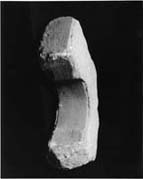Select a site alphabetically from the choices shown in the box below. Alternatively, browse sculptural examples using the Forward/Back buttons.
Chapters for this volume, along with copies of original in-text images, are available here.
Object type: Incomplete cross-head [1]
Measurements: H. 51 cm (20 in); W. 55 cm (21.7 in); D. 16 cm (6.3 in)
Stone type: Hartlepool and Roker dolomite
Plate numbers in printed volume: Pl. 82.416-418
Corpus volume reference: Vol 1 p. 95
(There may be more views or larger images available for this item. Click on the thumbnail image to view.)
Head, type A9. The lower arm, centre piece, and one horizontal arm survive. The two broad faces only are carved.
A (broad): The face is edged by a fine roll moulding. In the centre is a Lamb facing to the right with head turned back. It is shown with all four feet on the ground and there is no sign of a cross behind it. Little of the head survives, but part of the halo, on which there are two sunken roundels, is decipherable. There are two similar roundels, one in front of the Lamb, and one between its legs. On the right, and facing the Lamb is a figure with a similar nimbus and a book clasped between its front paws. The book has a single sunken roundel placed centrally. The creature's head is blunt and rounded, and could be leonine. It appears to have three pairs of wings, two pairs raised and another lying along its back. Below the feet of the Lamb is a frontal figure with two raised wings appearing behind its halo. The halo has three sunken roundels, and the head appears to be horned. To its right is a book with a central sunken roundel.
C (broad): A fine roll or flat-band moulding surrounds the face, but set back from the edge. The face is now too worn to be sure of the exact nature of the moulding. The centre piece is worn away but was surrounded by a similar moulding. On the lower and horizontal arms is a simple scroll with plain nodes. It is difficult to be certain of the plant details, but the leaves appear to be triangular, possibly serrated, and each volute encloses a long oval berry bunch.
The shallow relief and the unique carefully cut roundels (possibly representing jewels) imply that this piece was painted. The shape of the cross-head and the formula of covering one face with a plant-scroll is also found at Otley (Cramp 1974, pl. 45, 1 and 3), Lastingham (Collingwood 1927, 110, fig. 133), Masham (loc. cit.), all in Yorkshire, and Norham (no. 10), although the organization of this scroll and its fine shallow carving is unique. The iconography of the other face, in which the Lamb serves as a centre-piece surrounded by Evangelist symbols, has a long history even in Anglo-Saxon art (Cramp 1978b, 126-8). However, there are more surviving fragments with Evangelist symbols than with Lambs. On cross-heads at Otley (Cramp 1974, pl. 45, 4) only one symbol remains, likewise at Auckland St Andrew (no. 1) and Aycliffe (no. 9). At Halton, Lancashire, Ilkley, Yorkshire, and Sandbach, Cheshire, half-length busts with beasts' heads are found on the shafts, and it has been suggested that similar figures surround a cross at Lancaster (Coatsworth 1979, I, 30-3, II, 33, pl. 2). At Ramsbury, Wiltshire, and Wirksworth, Derbyshire, the Lamb, surrounded by symbols, is on a cross; at Hoddom, Dumfriesshire, the Lamb appears to stand alone (Collingwood 1927, fig. 51). The iconography of the Evangelist symbols in Insular art has been much discussed (Friend 1930; Kitzinger 1956; Crozet 1962; Werner 1969; Cramp 1978b, 122-6). It appears as though the figures here represent St Mark on the right and St Luke below, in which case the composition can be paralleled as early as the mid eighth century in the Laon Orosius manuscript 137, fol. 1 v. However, in Anglo-Saxon sculpture the symbols with multiple wings are only paralleled on the Durham cross-heads 5-7, where other apocalyptic figures of cherubim or seraphim are also found. The Hart head is clearly earlier than the Durham group and it is possible that it provided a model. However, the presence of symbols at Auckland St Andrew (no. 1), and the crude later representations at Aycliffe (no. 9) make one wary of seeing only one tradition in the southern part of co. Durham. The Hart cross has the appearance of the attenuated end of a tradition, but it seems unlikely it is later than the mid ninth century.



